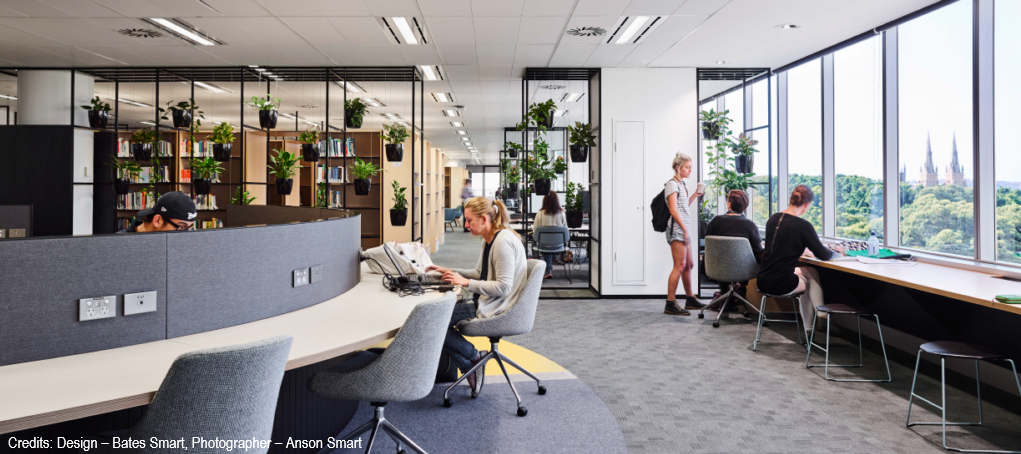Enhancing the student experience with learning space design

Learning space design is an emerging field of study that is gaining attention in higher education. By designing learning environments that support learner autonomy and resemble authentic workspaces, students are enabled to effectively engage in self-directed (independent) learning. Among other things, encouraging independent learning helps students to take responsibility for their own learning and make decisions about what they want to focus on.
Learning spaces are considered effective when they are designed for: home-like comfort, way-finding, balance, valued behaviour, openness, security and welcomeness (Parisio, 2013). These design elements help make a campus ‘sticky’; a space where students will want to learn, live and thrive as they customise their own learning experience.
Navitas campuses driven by design
Navitas campuses including Hyde Park Sydney Campus, UNIC in the UK, SAE Paris and SAE Vienna are just four examples of how learning space design is transforming the student learning experience and preparing them for their future careers.
Navitas campus Hyde Park Sydney
The Hyde Park Sydney Campus design was guided by the following four key principles:
- Encourage learner collaboration and community: features include moveable furniture, writable surfaces, projection facilities for ‘flipped’ learning, and the inclusion of communal spaces near classrooms for students to gather before and after class.
- Create spaces that are flexible and friendly for diverse use and technology by ensuring Wi-Fi is available throughout the building and have a ‘kit of parts’ suited to the intended pedagogies for the room.
- Support the diversity of each Navitas brand and diverse disciplines with themed floors and spaces that accommodate for different sizes of cohorts from 24 to 48 to 100.
- Create a highly ‘sticky’ campus focused on making students feel comfortable by providing learning commons and mixed learning areas including quiet spaces and collaboration zones.
University of Northampton International College (UNIC)
Similarly to the Hyde Park campus, the UNIC campus shares similar principles in design:
- Create spaces that encourage collaborative learning with light, moveable chairs and multiple glass boards to allow for group work.
- Be flexible and friendly for diverse use and technology with wall-mounted flat panel screens in classrooms, laptop charging stations, video capture options in class.
- Create a college that encourages, motivates and inspires by showcasing inspirational quotes from students and celebrities.
- Create a college focused on making students feel comfortable and informed by providing a warm ‘Welcome’ in different languages, selecting appropriate colours for moods e.g. bright colours to promote mental alertness.
Take a look at the before and after video for UNIC:
SAE Paris
The new SAE campus offers high-tech innovation spaces to attract new students and enrich the experience of current students. From interactive computer-based labs to small-scale creative hubs and project rooms, students have the opportunity to nurture the soft skills industry leaders increasingly want.
This campus aims to focus less on traditional lectures and isolated study and more on project-based learning and cross-campus collaboration. Lecturers are already developing more sophisticated and interactive lessons, for example, by using virtual reality technology or by interacting with students using mobile technology in the classroom as students are likely to have one or more mobile devices.
Take a look at the SAE Paris extension in the gallery below:
SAE Vienna
In September this year, a new European SAE campus in Vienna was officially opened. Established 31 years ago, SAE Vienna‘s recent relocation to the city centre marked its third relocation. Like all the newer SAE campuses and renovations, the design is influenced by two key principles: a ‘sticky’ campus that students want to be part of and to work within, and an authentic space which resembles the creative media industry.
The SAE Institute in Vienna intends to prepare students for their entry into the fast-paced and demanding media industry as well as to accompany and accelerate their careers.
Here are some more photos of the campus by Campus Manager Christian Ruff:
Has your college or school undergone a renovation inspired by learning space design principles? Share your thoughts and ideas about ways to design collaborative learning spaces via Yammer, Twitter and/or LinkedIn with the hashtag #learningspacedesign.
References
- Parisio, M. (2013). Designing learning spaces in higher education for autonomy: Preliminary findings and applications. In H. Carter, M. Gosper and J. Hedberg (Eds.), Electric Dreams. Proceedings ASCILITE 2013 Sydney. (pp.676-680)

